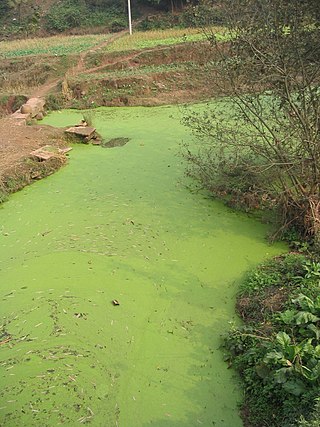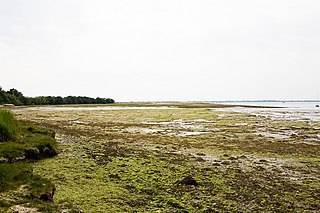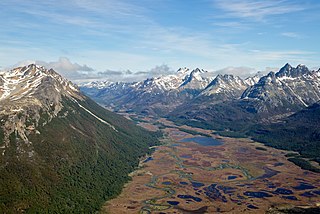Related Research Articles

A biome is a distinct geographical region with specific climate, vegetation, and animal life. It consists of a biological community that has formed in response to its physical environment and regional climate. Biomes may span more than one continent. A biome encompasses multiple ecosystems within its boundaries. It can also comprise a variety of habitats.

An ecoregion is an ecologically and geographically defined area that is smaller than a bioregion, which in turn is smaller than a biogeographic realm. Ecoregions cover relatively large areas of land or water, and contain characteristic, geographically distinct assemblages of natural communities and species. The biodiversity of flora, fauna and ecosystems that characterise an ecoregion tends to be distinct from that of other ecoregions. In theory, biodiversity or conservation ecoregions are relatively large areas of land or water where the probability of encountering different species and communities at any given point remains relatively constant, within an acceptable range of variation . Ecoregions are also known as "ecozones", although that term may also refer to biogeographic realms.

Eutrophication is a general term describing a process in which nutrients accumulate in a body of water, resulting in an increased growth of microorganisms that may deplete the water of oxygen. Although eutrophication is a natural process, manmade or cultural eutrophication is far more common and is a rapid process caused by a variety of polluting inputs including poorly treated sewage, industrial wastewater, and fertilizer runoff. Such nutrient pollution usually causes algal blooms and bacterial growth, resulting in the depletion of dissolved oxygen in water and causing substantial environmental degradation.

A wetland is a distinct ecosystem that is flooded or saturated by water, either permanently for years or decades or seasonally for a shorter periods. Flooding results in oxygen-free anoxic processes prevailing, especially in the soils. The primary factor that distinguishes wetlands from terrestrial land forms or water bodies is the characteristic vegetation of aquatic plants, adapted to the unique anoxic hydric soils. Wetlands are considered among the most biologically diverse of all ecosystems, serving as home to a wide range of plant and animal species. Methods for assessing wetland functions, wetland ecological health, and general wetland condition have been developed for many regions of the world. These methods have contributed to wetland conservation partly by raising public awareness of the functions some wetlands provide. Constructed wetlands are designed and built to treat municipal and industrial wastewater as well as to divert stormwater runoff. Constructed wetlands may also play a role in water-sensitive urban design.

Limnology is the study of inland aquatic ecosystems. The study of limnology includes aspects of the biological, chemical, physical, and geological characteristics of fresh and saline, natural and man-made bodies of water. This includes the study of lakes, reservoirs, ponds, rivers, springs, streams, wetlands, and groundwater. Water systems are often categorized as either running (lotic) or standing (lentic).

Resource depletion is the consumption of a resource faster than it can be replenished. Natural resources are commonly divided between renewable resources and non-renewable resources. The use of either of these forms of resources beyond their rate of replacement is considered to be resource depletion. The value of a resource is a direct result of its availability in nature and the cost of extracting the resource. The more a resource is depleted the more the value of the resource increases. There are several types of resource depletion, the most known being: Aquifer depletion, deforestation, mining for fossil fuels and minerals, pollution or contamination of resources, slash-and-burn agricultural practices, soil erosion, and overconsumption, excessive or unnecessary use of resources.
Freshwater ecosystems are a subset of Earth's aquatic ecosystems. They include lakes, ponds, rivers, streams, springs, bogs, and wetlands. They can be contrasted with marine ecosystems, which have a larger salt content. Freshwater habitats can be classified by different factors, including temperature, light penetration, nutrients, and vegetation. There are three basic types of freshwater ecosystems: Lentic, lotic and wetlands. Freshwater ecosystems contain 41% of the world's known fish species.

A tidal marsh is a marsh found along rivers, coasts and estuaries which floods and drains by the tidal movement of the adjacent estuary, sea or ocean. Tidal marshes experience many overlapping persistent cycles, including diurnal and semi-diurnal tides, day-night temperature fluctuations, spring-neap tides, seasonal vegetation growth and decay, upland runoff, decadal climate variations, and centennial to millennial trends in sea level and climate.

A riparian zone or riparian area is the interface between land and a river or stream. In some regions, the terms riparian woodland, riparian forest, riparian buffer zone, riparian corridor, and riparian strip are used to characterize a riparian zone. The word riparian is derived from Latin ripa, meaning "river bank".

Freshwater swamp forests, or flooded forests, are forests which are inundated with freshwater, either permanently or seasonally. They normally occur along the lower reaches of rivers and around freshwater lakes. Freshwater swamp forests are found in a range of climate zones, from boreal through temperate and subtropical to tropical.

Freshwater fish are those that spend some or all of their lives in fresh water, such as rivers and lakes, with a salinity of less than 1.05%. These environments differ from marine conditions in many ways, especially the difference in levels of salinity. To survive fresh water, the fish need a range of physiological adaptations.

Human impact on the nitrogen cycle is diverse. Agricultural and industrial nitrogen (N) inputs to the environment currently exceed inputs from natural N fixation. As a consequence of anthropogenic inputs, the global nitrogen cycle (Fig. 1) has been significantly altered over the past century. Global atmospheric nitrous oxide (N2O) mole fractions have increased from a pre-industrial value of ~270 nmol/mol to ~319 nmol/mol in 2005. Human activities account for over one-third of N2O emissions, most of which are due to the agricultural sector. This article is intended to give a brief review of the history of anthropogenic N inputs, and reported impacts of nitrogen inputs on selected terrestrial and aquatic ecosystems.

William Mitsch is an ecosystem ecologist and ecological engineer who was co-laureate of the 2004 Stockholm Water Prize in August 2004 as a result of a career in wetland ecology and restoration, ecological engineering, and ecological modelling.

Montane ecosystems are found on the slopes of mountains. The alpine climate in these regions strongly affects the ecosystem because temperatures fall as elevation increases, causing the ecosystem to stratify. This stratification is a crucial factor in shaping plant community, biodiversity, metabolic processes and ecosystem dynamics for montane ecosystems. Dense montane forests are common at moderate elevations, due to moderate temperatures and high rainfall. At higher elevations, the climate is harsher, with lower temperatures and higher winds, preventing the growth of trees and causing the plant community to transition to montane grasslands and shrublands or alpine tundra. Due to the unique climate conditions of montane ecosystems, they contain increased numbers of endemic species. Montane ecosystems also exhibit variation in ecosystem services, which include carbon storage and water supply.
The effects of climate change in Saskatchewan are now being observed in parts of the province. There is evidence of reduction of biomass in Saskatchewan's boreal forests that is linked by researchers to drought-related water stress stemming from global warming, most likely caused by greenhouse gas emissions. While studies, as early as 1988 have shown that climate change will affect agriculture, whether the effects can be mitigated through adaptations of cultivars, or crops, is less clear. Resiliency of ecosystems may decline with large changes in temperature. The provincial government has responded to the threat of climate change by introducing a plan to reduce carbon emissions, "The Saskatchewan Energy and Climate Change Plan", in June 2007.

A peatland is a type of wetland whose soils consist of organic matter from decaying plants, forming layers of peat. Peatlands arise because of incomplete decomposition of organic matter, usually litter from vegetation, due to water-logging and subsequent anoxia. Like coral reefs, peatlands are unusual landforms that derive mostly from biological rather than physical processes, and can take on characteristic shapes and surface patterning.
Nancy Tuchman is an American environmental scientist, educator, and activist. She specializes on human impacts on aquatic ecosystem function, with a focus on coastal Great Lake ecosystems. Tuchman is dedicated to raising public awareness about issues of global climate change and education. Her dedication is shown through her thirty years of educating students in environmental sciences at Loyola University Chicago. In 2013 she founded the Institute of Environmental Sustainability on Loyola University's campus - which later became the School of Environmental Sustainability in late 2020 - and is a driver of environmental change and progress in the Chicago area.
Petra Döll is a German hydrologist whose work focuses on modeling global water resources. She is a professor of hydrology and researcher at the Institute of Physical Geography, Goethe University Frankfurt.
Nandita Basu is a Professor and Canada Research Chair in Global Water Sustainability and Ecohydrology at the University of Waterloo. Her research is centered on anthropogenic effects on water availability and quality via changes in land use and climate. Basu is recognized for her work on discovering the impact of nutrient legacies and proposed solutions to improving water quality of lakes and coastal zones.

Fresh water or freshwater is any naturally occurring liquid or frozen water containing low concentrations of dissolved salts and other total dissolved solids. Although the term specifically excludes seawater and brackish water, it does include non-salty mineral-rich waters such as chalybeate springs. Fresh water may encompass frozen and meltwater in ice sheets, ice caps, glaciers, snowfields and icebergs, natural precipitations such as rainfall, snowfall, hail/sleet and graupel, and surface runoffs that form inland bodies of water such as wetlands, ponds, lakes, rivers, streams, as well as groundwater contained in aquifers, subterranean rivers and lakes. Fresh water is the water resource that is of the most and immediate use to humans.
References
- 1 2 "Irena Creed to lead School of Environment and Sustainability at U of S". Saskatoon StarPhoenix. 2017-07-31. Retrieved 2019-05-07.
- ↑ "University of Saskatchewan".
- ↑ "Irena Creed named U of T Scarborough's vice-principal, research and innovation". University of Toronto. 2021. Retrieved 2024-03-01.
- ↑ "Graduate Faculty Appointments March 2019". 2019.[ permanent dead link ]
- ↑ "UNU-INWEH Team". UNU-INWEH. 2019-03-04. Retrieved 2019-05-14.
- ↑ "Sweden's Umea University names Creed to visiting post". Western News. Western University. 2013. Retrieved 2024-03-01.
- ↑ "Irena Creed, Honorary Doctor of Agricultural Science". Swedish University of Agricultural Sciences. 2013. Retrieved 2024-03-01.
- ↑ "Renowned USask watershed scientist honoured by the Royal Society of Canada". University of Saskatchewan. 2019. Retrieved 2024-03-01.
- ↑ "Royal Society of Canada honours renowned USask researchers Creed, Dalai". University of Saskatchewan. 2020. Retrieved 2024-03-01.
- ↑ "Pay more attention to forests to avert global water crisis, researchers urge". Mongabay Environmental News. 2018-07-16. Retrieved 2019-05-07.
- ↑ "It's a Wide Wide World: The Impact of Open Science on Climate Science". Youtube. Ocean Pavilion. 2024. Retrieved 2024-03-03.
- ↑ "Creed leads new sustainability strategic plan". University of Saskatchewan. 2020. Retrieved 2024-03-03.
- ↑ "STRATEGIC PLAN CRITICAL PATH TO SUSTAINABILITY". University of Saskatchewan. 2024. Retrieved 2024-03-03.
- ↑ "Protecting and restoring the Great Lakes". ScienceDaily. 2012. Retrieved 2024-03-03.
- ↑ "WORLD SERIES VOL. 38 - FOREST AND WATER ON A CHANGING PLANET: VULNERABILITY, ADAPTATION AND GOVERNANCE OPPORTUNITIES". International Union of Forest Rearch Organizations. 2018. Retrieved 2024-03-03.
- ↑ ""The 2030 Agenda is our roadmap and its goals and targets are tools to get there."". Sustainable development goals. 2022. Retrieved 2024-03-03.
- ↑ Ellison, David; Morris, Cindy E.; Locatelli, Bruno; Sheil, Douglas; Cohen, Jane; Murdiyarso, Daniel; Gutierrez, Victoria; Noordwijk, Meine van; Creed, Irena F.; Pokorny, Jan; Gaveau, David; Spracklen, Dominick V.; Tobella, Aida Bargués; Ilstedt, Ulrik; Teuling, Adriaan J. (2017-03-01). "Trees, forests and water: Cool insights for a hot world". Global Environmental Change. 43: 51–61. doi:10.1016/j.gloenvcha.2017.01.002. ISSN 0959-3780.
- ↑ Creed, I. F.; Band, L. E.; Foster, N. W.; Morrison, I. K.; Nicolson, J. A.; Semkin, R. S.; Jeffries, D. S. (November 1996). "Regulation of Nitrate-N Release from Temperate Forests: A Test of the N Flushing Hypothesis". Water Resources Research. 32 (11): 3337–3354. Bibcode:1996WRR....32.3337C. doi:10.1029/96WR02399. ISSN 0043-1397.
- ↑ Creed, I. F.; Band, L. E. (November 1998). "Export of nitrogen from catchments within a temperate forest: Evidence for a unifying mechanism regulated by variable source area dynamics". Water Resources Research. 34 (11): 3105–3120. Bibcode:1998WRR....34.3105C. doi:10.1029/98WR01924. ISSN 0043-1397. S2CID 55714921.
- ↑ Creed IF, Band LE, Foster NW, Morrison IK, Nicolson JA, Semkin RS, Jeffries DS (1996-11-01). "Regulation of Nitrate-N Release from Temperate Forests: A Test of the N Flushing Hypothesis". Water Resources Research. 32 (11): 3337–3354. Bibcode:1996WRR....32.3337C. doi:10.1029/96WR02399. ISSN 1944-7973.
- ↑ Creed IF, Band LE (1998). "Export of nitrogen from catchments within a temperate forest: Evidence for a unifying mechanism regulated by variable source area dynamics". Water Resources Research. 34 (11): 3105–3120. Bibcode:1998WRR....34.3105C. doi:10.1029/98WR01924. S2CID 55714921.
- ↑ Enanga, E. M.; Creed, I. F.; Fairweather, T.; Casson, N. J. (September 2016). "Snow-covered soils produce N 2 O that is lost from forested catchments". Journal of Geophysical Research: Biogeosciences. 121 (9): 2356–2368. doi: 10.1002/2016JG003411 . ISSN 2169-8953.
- ↑ Creed IF, Taylor WD, Sibley P, Gaden M, Luzadis V, Bunting-Howart K, eds. (2015). "The Great Lakes Futures Project: Using Scenario Analysis to Develop a Sustainable Socio-ecologic Vision for the Great Lakes-St. Lawrence River Basin". Journal of Great Lakes Research. 41 (Supplement 1): 1–198. doi:10.1016/j.jglr.2014.12.017.
- ↑ "Assessing the ecological sustainability of a forest management system using the ISO Bowtie Risk Management Assessment Tool | Request PDF". ResearchGate. Retrieved 2019-05-14.
- ↑ Creed, Irena F.; McKnight, Diane M.; Pellerin, Brian A.; Green, Mark B.; Bergamaschi, Brian A.; Aiken, George R.; Burns, Douglas A.; Findlay, Stuart E.G.; Shanley, Jamie B.; Striegl, Rob G.; Aulenbach, Brent T.; Clow, David W.; Laudon, Hjalmar; McGlynn, Brian L.; McGuire, Kevin J. (August 2015). Smith, Ralph (ed.). "The river as a chemostat: fresh perspectives on dissolved organic matter flowing down the river continuum". Canadian Journal of Fisheries and Aquatic Sciences. 72 (8): 1272–1285. doi:10.1139/cjfas-2014-0400. ISSN 0706-652X.
- ↑ Creed, Irena F.; Bergström, Ann-Kristin; Trick, Charles G.; Grimm, Nancy B.; Hessen, Dag O.; Karlsson, Jan; Kidd, Karen A.; Kritzberg, Emma; McKnight, Diane M.; Freeman, Erika C.; Senar, Oscar E.; Andersson, Agneta; Ask, Jenny; Berggren, Martin; Cherif, Mehdi (August 2018). "Global change-driven effects on dissolved organic matter composition: Implications for food webs of northern lakes". Global Change Biology. 24 (8): 3692–3714. Bibcode:2018GCBio..24.3692C. doi:10.1111/gcb.14129. ISSN 1354-1013. PMID 29543363. S2CID 4930039.
- ↑ Reid, Andrea J.; Carlson, Andrew K.; Creed, Irena F.; Eliason, Erika J.; Gell, Peter A.; Johnson, Pieter T. J.; Kidd, Karen A.; MacCormack, Tyson J.; Olden, Julian D.; Ormerod, Steve J.; Smol, John P.; Taylor, William W.; Tockner, Klement; Vermaire, Jesse C.; Dudgeon, David (June 2019). "Emerging threats and persistent conservation challenges for freshwater biodiversity". Biological Reviews. 94 (3): 849–873. doi:10.1111/brv.12480. ISSN 1464-7931. PMID 30467930.
- ↑ Paltsev, Aleksey; Creed, Irena F. (April 2022). "Multi-decadal changes in phytoplankton biomass in northern temperate lakes as seen through the prism of landscape properties". Global Change Biology. 28 (7): 2272–2285. doi:10.1111/gcb.16079. ISSN 1354-1013. PMID 35014108. S2CID 247671025.
- ↑ Paltsev, Aleksey; Creed, Irena F. (2022-04-01). "Are Northern Lakes in Relatively Intact Temperate Forests Showing Signs of Increasing Phytoplankton Biomass?". Ecosystems. 25 (3): 727–755. Bibcode:2022Ecosy..25..727P. doi:10.1007/s10021-021-00684-y. ISSN 1435-0629. S2CID 254076792.
- ↑ Paltsev, Aleksey; Creed, Irena F. (April 2022). "Multi-decadal changes in phytoplankton biomass in northern temperate lakes as seen through the prism of landscape properties". Global Change Biology. 28 (7): 2272–2285. doi:10.1111/gcb.16079. ISSN 1354-1013. PMID 35014108. S2CID 247671025.
- ↑ Erratt, Kevin J.; Creed, Irena F.; Trick, Charles G. (April 2020). Palenik, B. (ed.). "Differential Drawdown of Ammonium, Nitrate, and Urea by Freshwater Chlorophytes and Cyanobacteria 1". Journal of Phycology. 56 (2): 458–468. Bibcode:2020JPcgy..56..458E. doi:10.1111/jpy.12960. ISSN 0022-3646. PMID 31875965.
- ↑ Rains, M. C.; Leibowitz, S. G.; Cohen, M. J.; Creed, I. F.; Golden, H. E.; Jawitz, J. W.; Kalla, P.; Lane, C. R.; Lang, M. W.; McLaughlin, D. L. (January 2016). "Geographically isolated wetlands are part of the hydrological landscape". Hydrological Processes. 30 (1): 153–160. Bibcode:2016HyPr...30..153R. doi:10.1002/hyp.10610. ISSN 0885-6087.
- ↑ Cohen, Matthew J.; Creed, Irena F.; Alexander, Laurie; Basu, Nandita B.; Calhoun, Aram J. K.; Craft, Christopher; D’Amico, Ellen; DeKeyser, Edward; Fowler, Laurie; Golden, Heather E.; Jawitz, James W.; Kalla, Peter; Kirkman, L. Katherine; Lane, Charles R.; Lang, Megan (2016-02-23). "Do geographically isolated wetlands influence landscape functions?". Proceedings of the National Academy of Sciences. 113 (8): 1978–1986. Bibcode:2016PNAS..113.1978C. doi: 10.1073/pnas.1512650113 . ISSN 0027-8424. PMC 4776504 . PMID 26858425.
- ↑ Golden, Heather E; Creed, Irena F; Ali, Genevieve; Basu, Nandita B; Neff, Brian P; Rains, Mark C; McLaughlin, Daniel L; Alexander, Laurie C; Ameli, Ali A; Christensen, Jay R; Evenson, Grey R; Jones, Charles N; Lane, Charles R; Lang, Megan (August 2017). "Integrating geographically isolated wetlands into land management decisions". Frontiers in Ecology and the Environment. 15 (6): 319–327. Bibcode:2017FrEE...15..319G. doi:10.1002/fee.1504. ISSN 1540-9295. PMC 6261316 . PMID 30505246.
- ↑ Creed, Irena F.; Lane, Charles R.; Serran, Jacqueline N.; Alexander, Laurie C.; Basu, Nandita B.; Calhoun, Aram J. K.; Christensen, Jay R.; Cohen, Matthew J.; Craft, Christopher; D'Amico, Ellen; DeKeyser, Edward; Fowler, Laurie; Golden, Heather E.; Jawitz, James W.; Kalla, Peter (November 2017). "Enhancing protection for vulnerable waters". Nature Geoscience. 10 (11): 809–815. Bibcode:2017NatGe..10..809C. doi:10.1038/ngeo3041. ISSN 1752-0908. PMC 6071434 . PMID 30079098.